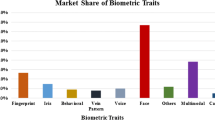Abstract
Behavioral biometrics is the field of study related to person identification based on the way an activity is performed. Despite the difficulties of implementation and achieving high recognition metrics, this field has advantages that attract the interest of the scientific community. In the case of gait analysis, active interaction between the user and the acquisition device is not required. This enables signals to be safely assessed remotely, that is important in the times of pandemic. Furthermore, it is not easy to deliberately mimic a person’s gait. The work concerns on the development of system that enables identifying individuals based on gait with the use of wearable sensors such as accelerometers or gyroscopes. The work describes the data preprocessing pipeline and the innovative data augmentation mechanism performed with the use of generative models. The validation of the system is carried out using three different datasets collected under laboratory, semi-laboratory and field conditions. This article focuses on presenting a comprehensive solution, with a special authors’ aspect of data augmentation.
Access this chapter
Tax calculation will be finalised at checkout
Purchases are for personal use only
Similar content being viewed by others
References
“Biometrics - a biometric system for identifying persons using their gait, POIR.01.01.01-00-1942/20. Accessed 16 Mar 2023
“Beyond the state-of-the-art biometrics on the move for border checks” project page. https://ec.europa.eu/info/funding-tenders/opportunities/portal/screen/opportunities/topic-details/horizon-cl3-2023-bm-01-03. Accessed 16 Mar 2023
Roy, A., Memon, N., Ross, A.: MasterPrint attack resistance: a maximum cover based approach for automatic fingerprint template selection. In: IEEE 10th International Conference on Biometrics Theory, Applications and Systems (BTAS), pp. 1–9 (2019)
Wan, C., Wang, L., Phoha. V.V.: A survey on gait recognition. ACM Comput. Surv. 51, 5, Article 89 (2019). https://doi.org/10.1145/3230633
Perception Neuron 32 official website. https://neuronmocap.com/products/perception_neuron/. Accessed 16 Jan 2019
SIGNET research, Smartphone gait signals dataset, Department of Information Engineering, University of Padova, Italy. https://signet.dei.unipd.it/research/ Accessed 02 April 2023
Gadaleta, M., Rossi, M.: IDNet: Smartphone-based gait recognition with convolutional neural networks. Pattern Recogn. 74, 25–37 (2018)
Vajdi, A., et al.: Human gait database for normal walk collected by smart phone accelerometer. arXiv preprint arXiv:1905.03109 (2019)
Matovski, D., et al.: The effect of time on gait recognition performance. Trans. Inf. Forensics Secur. 7(2), 543–552 (2011)
Sawicki, A., Saeed, K.: Application of LSTM networks for human gait-based identification. In: Zamojski, W., Mazurkiewicz, J., Sugier, J., Walkowiak, T., Kacprzyk, J. (eds.) Theory and Engineering of Dependable Computer Systems and Networks. DepCoS-RELCOMEX 2021. Advances in Intelligent Systems and Computing, vol. 1389, pp. 402–412. Springer, Cham (2021). https://doi.org/10.1007/978-3-030-76773-0_39
Whittle, M.: Gait Analysis: an Introduction. Butterworth-Heinemann, Oxford (1991)
Graves A.: Generating sequences with recurrent neural networks. arXiv:1308.0850 (2013)
Alzantot, M., Chakraborty, S., Srivastava, M.: SenseGen: a deep training architecture for synthetic sensor data generation. In: 2017 IEEE International Conference on Pervasive Computing and Communications Workshops (PerCom Workshops) (2017)
Chadebec, C., Thibeau-Sutre, E., Burgos, N., et al.: Data augmentation in high dimensional low sample size setting using a geometry-based variational Autoencoder. arXiv:2105.00026 (2021)
Pyraug augmentation framework official reposity. https://github.com/clementchadebec/pyraug. Accessed 16 Mar 2023
Huang, H., Zhou, P., Li, Y., Sun, F.: A Lightweight attention-based CNN model for efficient gait recognition with wearable IMU sensors. Sensors 2021, 21, 2866 (2021)
Acknowledgment
This work was supported by grant 2021/41/N/ST6/02505 from Białystok University of Technology and funded with resources for research by National Science Centre, Poland. For the purpose of Open Access, the author has applied a CC-BY public copyright license to any Author Accepted Manuscript (AAM) version arising from this submission.
Author information
Authors and Affiliations
Corresponding author
Editor information
Editors and Affiliations
Rights and permissions
Copyright information
© 2023 The Author(s), under exclusive license to Springer Nature Switzerland AG
About this paper
Cite this paper
Sawicki, A., Saeed, K. (2023). Gait-Based Biometrics System. In: De Francisci Morales, G., Perlich, C., Ruchansky, N., Kourtellis, N., Baralis, E., Bonchi, F. (eds) Machine Learning and Knowledge Discovery in Databases: Applied Data Science and Demo Track. ECML PKDD 2023. Lecture Notes in Computer Science(), vol 14175. Springer, Cham. https://doi.org/10.1007/978-3-031-43430-3_29
Download citation
DOI: https://doi.org/10.1007/978-3-031-43430-3_29
Published:
Publisher Name: Springer, Cham
Print ISBN: 978-3-031-43429-7
Online ISBN: 978-3-031-43430-3
eBook Packages: Computer ScienceComputer Science (R0)





